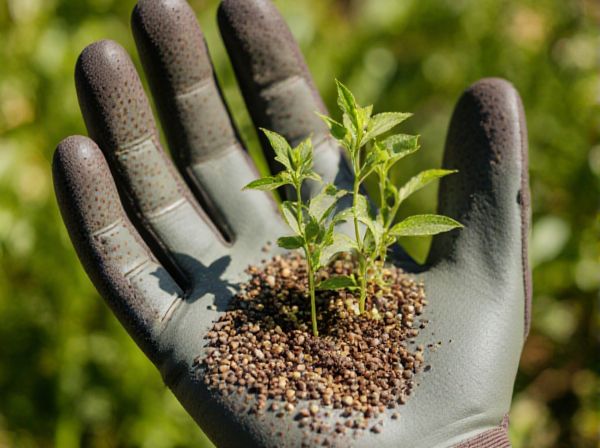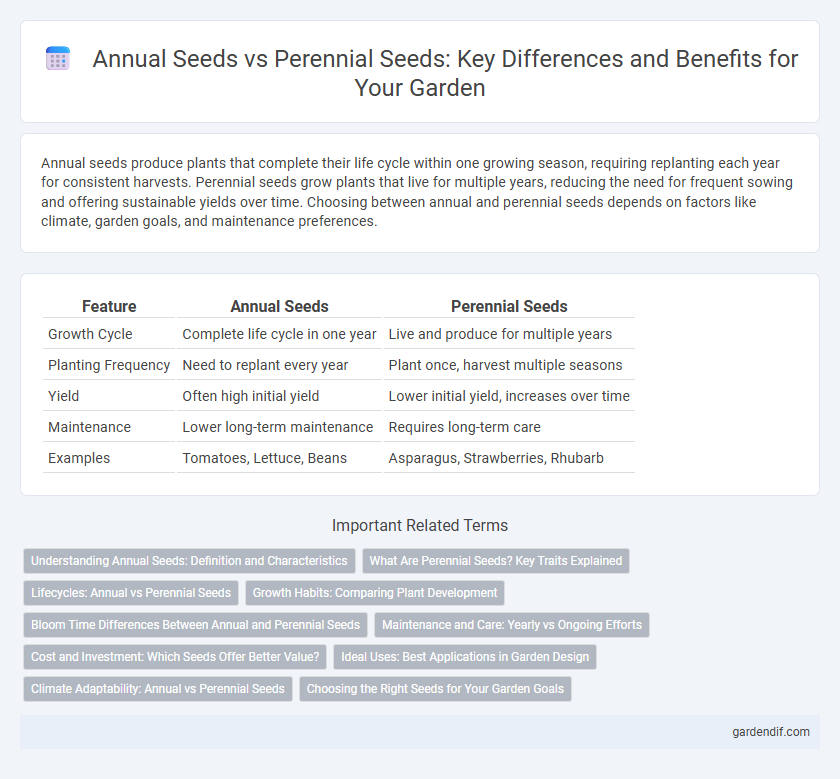
Annual Seeds vs Perennial Seeds Illustration
Annual seeds produce plants that complete their life cycle within one growing season, requiring replanting each year for consistent harvests. Perennial seeds grow plants that live for multiple years, reducing the need for frequent sowing and offering sustainable yields over time. Choosing between annual and perennial seeds depends on factors like climate, garden goals, and maintenance preferences.
Table of Comparison
| Feature | Annual Seeds | Perennial Seeds |
|---|---|---|
| Growth Cycle | Complete life cycle in one year | Live and produce for multiple years |
| Planting Frequency | Need to replant every year | Plant once, harvest multiple seasons |
| Yield | Often high initial yield | Lower initial yield, increases over time |
| Maintenance | Lower long-term maintenance | Requires long-term care |
| Examples | Tomatoes, Lettuce, Beans | Asparagus, Strawberries, Rhubarb |
Understanding Annual Seeds: Definition and Characteristics
Annual seeds come from plants that complete their entire life cycle, from germination to seed production, within one growing season. These seeds typically require replanting each year and are adapted to rapidly mature and produce fruit or flowers before the season ends. Understanding the traits of annual seeds helps gardeners optimize planting schedules for crops like tomatoes, lettuce, and marigolds that thrive in single-year cycles.
What Are Perennial Seeds? Key Traits Explained
Perennial seeds produce plants that live for multiple growing seasons, regrowing each year from the same root system. These seeds typically exhibit traits such as deep root structures, drought tolerance, and the ability to store nutrients, enabling sustained growth over years. Unlike annual seeds, perennial seeds support long-term ecosystem stability and reduce the need for repeated planting and soil disturbance.
Lifecycles: Annual vs Perennial Seeds
Annual seeds complete their entire lifecycle--germination, growth, flowering, seed production, and death--within a single growing season, requiring replanting each year. Perennial seeds grow into plants that live for multiple years, producing flowers and seeds annually after the initial maturation period without needing to be reseeded. Understanding these lifecycle differences helps gardeners select seeds based on maintenance preferences and long-term garden planning.
Growth Habits: Comparing Plant Development
Annual seeds produce plants that complete their entire life cycle--from germination to seed production--within a single growing season, resulting in rapid growth and reproduction. Perennial seeds grow into plants that develop extensive root systems and structural components, allowing them to survive multiple years and produce seeds repeatedly. Understanding these growth habits is crucial for optimizing garden design, crop rotation, and long-term yield strategies.
Bloom Time Differences Between Annual and Perennial Seeds
Annual seeds produce plants that complete their life cycle within a single growing season, resulting in a rapid bloom time typically lasting a few months. Perennial seeds grow plants that live for multiple years, often taking longer to bloom initially but offering repeated flowering seasons over time. Understanding these bloom time differences is crucial for gardeners seeking immediate vibrant color versus long-term garden sustainability.
Maintenance and Care: Yearly vs Ongoing Efforts
Annual seeds require planting, watering, and fertilizing each year, demanding consistent seasonal effort to ensure growth and productivity. Perennial seeds, once established, need less frequent maintenance, with ongoing care focused mainly on pruning and occasional feeding to sustain longevity. The choice between annual and perennial seeds significantly impacts the time and labor invested in garden upkeep.
Cost and Investment: Which Seeds Offer Better Value?
Annual seeds generally require buying new seeds every year, leading to higher long-term costs, while perennial seeds provide repeated harvests over multiple seasons, offering better investment value. Although annual crops often yield faster returns, the recurring expense of purchasing seeds can accumulate, making perennials cost-efficient for sustained growth. Investing in perennial seeds reduces seed costs and labor over time, presenting a more economical choice for gardeners prioritizing long-term savings.
Ideal Uses: Best Applications in Garden Design
Annual seeds are ideal for creating vibrant, seasonal displays and quick garden transformations, offering intense bursts of color and variety within a single growing season. Perennial seeds provide long-term structure and sustained growth, perfect for establishing stable garden borders and reducing replanting efforts year after year. Combining annuals and perennials maximizes garden aesthetics, balancing immediate impact with lasting foundation in garden design.
Climate Adaptability: Annual vs Perennial Seeds
Annual seeds are typically adapted to complete their life cycle within one growing season, making them more suitable for climates with predictable seasonal changes and shorter growing periods. Perennial seeds develop plants that survive multiple years, offering greater resilience to fluctuating climates and extreme weather by establishing deep root systems that access water and nutrients over time. This climate adaptability allows perennials to provide sustainable ground cover and erosion control, while annuals excel in rapid growth and regeneration under stable conditions.
Choosing the Right Seeds for Your Garden Goals
Annual seeds produce plants that complete their life cycle in one growing season, making them ideal for gardeners seeking quick blooms or harvests. Perennial seeds grow plants that return year after year, offering long-term garden stability and reduced replanting efforts. Selecting between annual and perennial seeds depends on desired garden duration, maintenance level, and aesthetic preferences.
Annual Seeds vs Perennial Seeds Infographic

 gardendif.com
gardendif.com